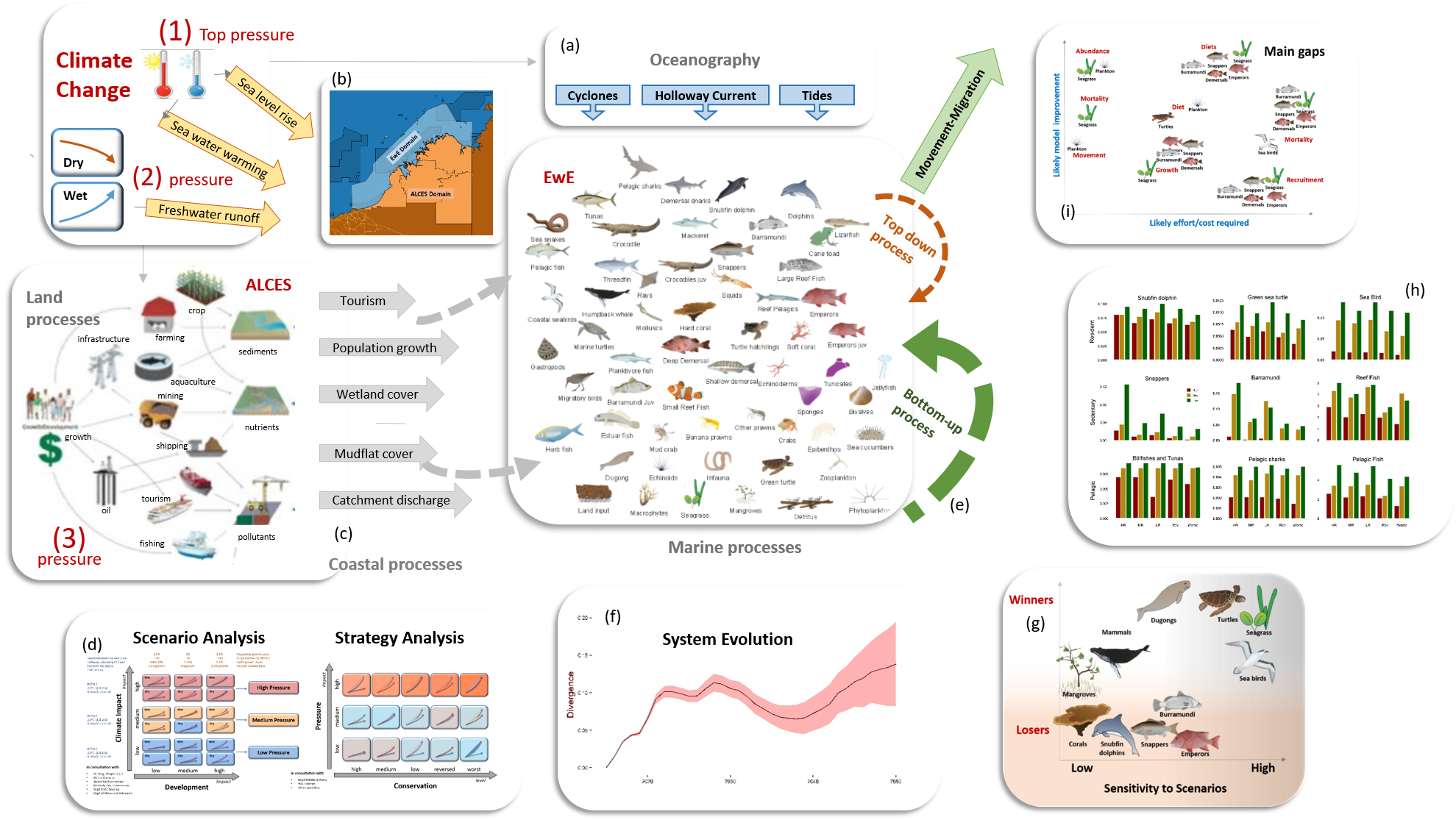Project title: Knowledge integration and Management Strategy Evaluation modelling
Program: Kimberley Marine Research Program
Modelling the future of the Kimberley region
Introduction
In this project we have explored the possible and desired futures of the Kimberly region. We have used two computer models, Ecopath with Ecosim and Alces. The futures we have explored have been determined in consultation with stakeholders and interested parties.
This site describes the approach we have followed. We start by explaining why we use computer models and what it means to explore regional futures. We then provide some information about what models we have used and the geographical extent of the model domains. We proceed by describing the scenarios and management strategies we modelled. This site also includes all simulation results. Use the links on the left-hand side to cover all this material. You can also view our online Prezi presentation and an interactive visualisation of Ecopath with Ecosim foodweb.
How does the Kimberley system work?
Figure 1 below summarises this project by capturing its scope, what we learnt about the functioning of the overall Kimberley and the core results of this research. The marine ecosystem (EwE panel) receives pressure from both natural and anthropogenic land-based processes (ALCES panel) mediated by a number of coastal processes (panel c) which include tourism, population growth, changes in wetland and mudflat covers as well as catchment discharges in term of nutrient, sediments and pollutants.
 |
Figure 1. Conceptual model of the functioning of the Kimberley system, including the main result from this project |
The marine ecosystem is also driven by oceanographic processes (panel a) which include cyclones, current and tides. All these processes act at a regional scale, which motivated the choice of the model domains (panel c). Acting at a larger scale, climate change has an impact on the marine environment both directly, in the form of sea level rise and sea surface warming and indirectly by altering precipitation regimes, affecting ocean currents and potentially impacting on a number of land processes (fire regiments, viability of agriculture and farming industry, etc). Climate change can also affect the marine ecosystem by altering some biological and metabolic processes in marine life forms, with potentially profound effects whose details are currently largely uncertain. The computer models used on this work include all of these processes either directly as model components, or indirectly in the form of model parameters or external forcing. Parametrising Ewe and the ALCES models so that they can represent the Kimberley land and marine systems to the very best of our current knowledge should be considered as one of the main legacy this project will leave which we hope will be used for further research.
These models have then been used to test the system’s response to specific conditions (scenarios) and management options which the project stakeholders have recognised as most plausible and of management significance (panel d). By using the models we have learnt that the number of scenarios we tested can be grouped into three main levels of pressure (Scenario Analysis in panel d) largely as a result of climate change induced warming being the stressor which largest impact on the system, followed by the changes in precipitation regimes and socio-economic development. Nevertheless, these stressors do interact. As a result, given a specific level of climate change warming, socio-economic development can add further significant pressure to a system already under stress (Strategy Analysis in panel d and panel h).
We have also learnt that, irrespective of the modelled scenarios, the system displays behaviours which are intrinsic to its own dynamics. These include a clear bottom-up dynamics (panel e) and an oscillation in the distribution of its biomass with a main period of around 20 years. While the details are largely uncertain, this internal dynamics deserves further investigation since it has the potential of affecting the system resilience to both major natural and man-made events.
Different species in the marine foodweb are likely to respond differently to the pressure described above. Panel g shows that some species are ‘winners’, that is are likely to see their biomass increase under most modelled scenarios, while others may lose out. Also, some species are likely to show more sensitivity to scenario variability than others. Similarly, species may respond differently to the management strategies we modelled (panel h) and overall management of the marine parks in terms of sanctuary area extent, has the potentially to considerably alleviate the pressure imposed on the system by the interaction of climate and development stressors.
Obviously, almost every aspect of this work could be improved by including better information on local marine processes and more and better data on the modelled species. Should resource become available to further this work, choices will have to be made to decide what improvement should take priority. To this aim, in panel i we provide an approximate classification in terms of likely impact on the model performance vs the expected effort and cost in collecting better data.